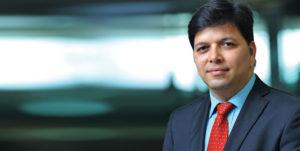Milind Apte, Senior Vice President, HR at Ceat Tyres and a former professional Badminton player, talks about the lessons he learnt in his professional journey of 22 years, Ceat’s HR policies, its evolution and how it is encouraging a culture of outperformance.

“Unless you understand business well, you will not be able to offer good quality HR services,” says Milind Apte, Senior Vice President, HR, Ceat Tyres. With over 22 years of HR experience across sectors including manufacturing and real estate industries, Apte’s journey is filled with rich lessons and anecdotes. A management graduate, Apte worked as a Chief People Officer at Godrej Properties Ltd before he joined CEAT in December 2016. He has also worked for companies like Hershey’s Ltd., DHL Express, Cadbury India Ltd. and Johnson & Johnson Ltd. An erstwhile professional Badminton player who represented tournaments both at the State and National Levels, Apte has had a lot of takeaways from the world of sports, that helps him with team building and other HR activities. In this interview, he reminisces learnings from his professional journey, talks about CEAT’s HR policies and how the organisation is heading to becoming one that encourages a culture of outperformance.
Excerpts from the interview (as narrated in first person):
Key learnings from your career
When you start your career in HR, you feel that if you know the concept of HR well, you will be successful. But, over a period of time you realise that unless you understand the business and customise the entire way of offering HR solutions you are not going to be successful.
Irrespective of the industry you work in, people are the true asset to an organisation and irrespective of the industry, they behave in the same way. If you go with that fundamental understanding, and that people have a pattern in which they behave and operate, you will be able to offer good HR services.
Also, HR is truly valued if it is able to really move ahead of the curve. Let’s assume an organisation is moving at a pace. I have two choices: one, I move at the same pace. Two, I move faster than the organisation’s pace and welcome it at the new destination. This is thinking ahead of the curve.
It is not about what HR wants to do in the organisation. Have you helped the organisation build the right people with right competence? From a long term growth perspective what role do you play? I may call for celebrations and compensation reviews on time, but none of this matters in the long run. What matters is: have you, over the long term, built the right competence, right mind set, the right people, who have contributed in growing the organisation.
Another thinking is that being humble is extremely critical, irrespective of which position and business you are in. If you are humble and authentic, that has the power to bring you closer to people and leads to a far superior HR delivery.
Last one, ability to build relationships. It is not your designation which matters; it is the relationship that you have built which defines your success.
When I moved from FMCG to real estate, I was told that it is unorganised and I would find it difficult to work in this sector. But I realised that it is the business cycles that are different, people are the same. People behave in the same manner. What is going to be different is the life cycle of the business and the stage of the lifecycle in which it is and our ability to bring HR solutions for that life cycle.
Role of HR in Ceat Tyres
I joined the organisation at the right time, when the role of HR was turning more strategic than an operational one. Over the last five years, CEAT has gone aggressive in terms of its vision and has grown well. Our vision is very ambitious at the stage that we are in and hence, incremental changes will not help us anymore. To make this happen, HR will partner with business in the company’s transformation. For example, we have an ambition now of multiplying our profitability 4 times in the next 5 years. Here, it’s not about the number but about changing the mind-set, as the thinking needed to reach this target is different.
So how do you take the organisation to culture of outperformance from just performance and bring the entire mind-set towards growth, where big targets don’t demotivate you but inspire you. We want to go beyond performance management and ignite outperformance and give disproportionate results.
Everything we do today should lead to building this culture of outperformance over the next 4 to 5 years.

Evolution of our HR policies
Over the last five years, all our policies have been shaped, keeping in mind the larger journey of enhancing our performance and bringing in a culture which is driven by openness and flexibility. And hence, from a prescriptive and guided policy, we have moved towards an evolved and flexible policy. This is driven by the fact that freedom and flexibility improves the performance dramatically. This is also designed keeping in mind the millennials and we have a large population of them in our organisation.
Let me cite a few examples: One, almost 65 per cent of all our open positions are being filled by candidates from within the organisation. Two, we have done away with attendance recording system. Three, we have moved from say, 180 days of leave accumulation to only 30 days, there by encouraging people to have a work-life balance by availing that leave. We are moving towards making leave accumulation zero.
Current people related challenges
I will not call it a challenge. But, when you change gears, there is bound to be some discomfort.
CEAT is a very people-centric organisation with an attrition rate of 7 per cent to 8 per cent. They are used to a way of working which has been fantastic. When we start looking at outperformance and transformation of the organisation, the important thing is to make sure that people are comfortable in this journey. There is bound to be discomfort, but our presence there to address it is important.
Second, we need to prepare those who are going to lead this transformation so that they don’t crack in this journey.
Third, in a stable organisation, you don’t necessarily need the ability to inspire every time. So the challenge is, would you want to build competency to influence and inspire people which may not be at the same level today and that wasn’t needed earlier. But as you start spreading faster, the chances of wear and tear is high. So, metaphorically speaking, will you supported by physiotherapy and the right medical kit?
Fourth, when we talk about culture of outperformance, will we also support it with aggressive value proposition for employees. People will say I was happy running at 80kms in 24 hours, if want me to run at 200 kms now, what’s in it for me. We need to realise that in this entire journey there are going to be ruptures and injuries. Are we prepared to handle this?
Finally, we need to handle a diverse workforce. This will become important in a stable manufacturing organisation like CEAT.
It is not your designation which matters; it is the relationships that you have built which defines your success
![]()
Approach to Performance Management
Performance management is all about enhancing the organisation’s performance in its entirety. Are you making sure that you are building tremendous sense of ownership in the minds of employees? If you are asking people to run faster, is your entire reward philosophy in line with this thought. Disproportionate and differentiated rewards will lead to disproportionate performance. This is what will create a culture of performance.
The entire effort is to make sure that you are building strong processes, create ownership and bring strong reward and recognition philosophy, which will commensurate with performance expectations. We are following a concept called QBM – quality-based management which doesn’t speak about result, but about the mind-set transformation.
Performance management is all about making sure that the transformation is happening in people’s mind through a rigorous process orientation which fundamentally connects all the drivers, which impact the performance in the long run.
Any activities done by CEAT to boost Employer Branding
It is done largely at the group level. RPG group stands tall when it comes to employer branding. We have always been known as an extremely people centric organisation. Have we consciously gone out and marketed CEAT and its culture? We have just begun the journey. Entire brand building is happening in campuses.
Key focus to build a successful organisation
While I spoke of culture of outperformance, I’d like to say that this culture is the outcome. But will I be able to deliver this and create a culture that ignites this passion, a culture that inspires people, a culture which makes people think that “this is my business” and take on targets without fear of failure. That is a big differentiation and that is the kind of organisation that we would love to create.
On the HR-Tech ecosystem.
Social media tools are very strong and we are also using it extensively. It is helping us in recruitment; For example, LinkedIn has become an important a source. Whatsapp may sound irrelevant but the kind of change created through this is helping us speed up the entire communication process. This is replacing our formal communication channel to a large extent. The entire technology drive is challenging the way we were engaging and inspiring people. We are moving on to platforms, virtual platforms, which are available at low Internet speed of 100 kbps – be it for learning, communication, recruitment, engagement and interaction.
As far as AI is concerned, we are excited about the ability to capture multiple data points for an employee or prospective employee and make sense out of the data captured. While we are excited about Artificial intelligence, we are also a little mindful of it and not jumping on to the bandwagon without understanding the importance of what we are doing.
You are a professional Badminton player and have represented tournaments both at State and National Levels. Lessons you take away from this sport.
Let me first deal with the not so good part – Sports injury. Injuries have a tremendous potential to knock you off or keep you away from the game for a long time. What it does to you psychologically is, assume you are doing well and suddenly get injured. From a confidence point of view, one tends to be shattered for a long time. Physical capability to reach that stage is long. Sport teaches you the ability to hold yourself during bad times, have patience and wait for your time to come while taking extra ordinary efforts. When you have sports injuries, you increase your efforts to get back into form. It builds that ability to fight.
Next is defeat. You may face defeat in a game many times, but the ability to not get overwhelmed by a win or loss and focus on preparation plays an important role.
How I directly bring that entire learning here today: if I go to my management committee on some thoughts on leading the organisation and if it is not acknowledged, not letting your ego come in the way is important.
When we negotiate with juniors and they threaten to go on strike, you know that you have given your best, but if a strike happens, it doesn’t impact you. The important question is where you prepared well both mentally and physically? I was defeated in yesterday’s match and today is a new day.
Decide to win. In sports, you want to win. And that too consistently. This will ensure that you raise your bar of performance consistently.
The level of energy you bring is that of pure optimism. A sports person always brings optimism, as they never say I will fail. It also teaches you to be a team player and teaches you to carry yourself in front of a large crowd. It is about silencing your critiques with your performance rather than arguments and about being graceful in defeat. This reflects in your professional life, where you stay away from giving excuses.
It has been a game changer and I never thought that it can contribute so dramatically to me.
Key skill sets needed for the next decade of younger professionals
- Growth and learning mind-set
- Agility
- Ability to execute flawlessly
- Innovation mind-set – innovation of small things and not only big ones
- Bringing incremental difference to the way you are look at things
- Extreme level of flexibility
- Ability to go beyond individualism and be a team player
- Keep learning and make sure that you are relevant
- Evolve into a team player
